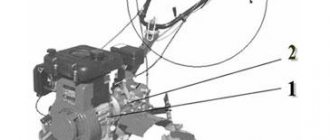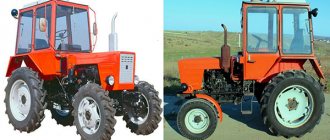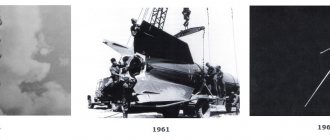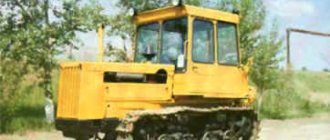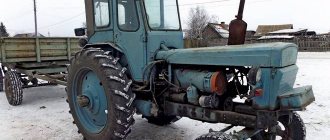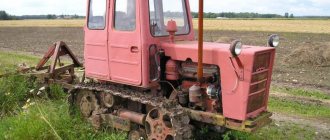Motoblock Ugra NMB 1 - technical specifications, operating instructions
Manufacturer of NMB-1 Ugra walk-behind tractors - JSC Kaluga Engine, (CADVI) Kaluga, st.
Moskovskaya, 247 Today Kaluga Engine OJSC is a modern diversified enterprise, highly mechanized and automated, equipped with unique technological equipment. More than 37 years of production experience is a guarantee of quality and high reliability of products. The development of production at the enterprise is proceeding in several directions. First of all, this is the production of complex and high-tech products.
The history of the enterprise began in 1966, when a new enterprise was created on the basis of one of the workshops of the Kaluga Turbine Plant and the Kaluga branch of the Research Automobile and Automotive Engine Institute - the Kaluga Experimental Motor Plant.
Official website of the manufacturer of the NMB-1 Ugra walk-behind tractor https://www.kadvi.ru
The NMB-1 Ugra walk-behind tractor is a powerful, reliable, safe machine. The best confirmation of quality is a two-year guarantee. In combination with mounted implements, it performs a diverse range of work: cultivating the soil, mowing, spraying, watering, digging and planting potatoes, transporting cargo, removing snow. Two power take-off shafts make the walk-behind tractor universal and make it easy to connect a wide range of additional attachments, such as a water pump.
The gearbox and drive reducer are gear-type, the clutch is made of metal-ceramic discs, which significantly increases the reliability of operation. These design elements are inherent in professional equipment. The absence of drive V-belts completely eliminated the problems associated with them: slipping, jumping off, and breakage. The gearbox has 3 forward and 1 reverse speeds, which optimizes work with trailed and mounted implements.
Speed optimization
| Broadcast | Speed km/h | Soil and attachments |
| 1 | up to 3.61 | Work on heavy soils, potato planter, trailer with load, adapter. |
| 2 | up to 5.88 | Work on light soils, cultivators on heavy soils |
| 3 | until 8.52 | Cultivators on light soils, driving with a trailer on roads |
| back | up to 2.28 | Rotary mower, snow blower. |
The steering column is easily adjustable in vertical and horizontal planes and has vibration protection.
Turning the steering wheel in a horizontal plane allows you to avoid “trampling” the soil during cultivation. “Ugra” is the only Russian walk-behind tractor made in accordance with European safety standards. The control system (red engine stop handle (left handle) black reverse clutch lock lever (right handle) allows you to instantly and safely stop the unit in an emergency. Two power take-off shafts on the gearbox allow stationary work on a wide range of attachments: circular saw , feed crusher, water pump, earth drill and others.
With minimal disassembly, the walk-behind tractor easily fits in the trunk of any passenger car, which makes transportation much easier.
Technical characteristics of the NMB-1 Ugra walk-behind tractor
| Technical Specification Parameter | Parameter value |
| Structural weight (with cultivator/pneumatic wheels), kg | 85/84 |
| Operating weight (with cultivator/pneumatic tires), kg. | 91/90 |
| Shipping weight, kg. | 61 |
| Traction force with pneumatic wheels, kgf (Kn) | 100 (0,98) |
| Traction force with metal wheels, kgf (Kn) | 130 (0,98) |
| Transport gauge, adjustable, mm. | 405, 695 |
| Ground clearance with wheels, mm. | 170 |
| Total weight of the towed trolley, kg. | 350 |
| Wheel tires | 4.0x10 |
| Gap between spark plug electrodes, mm | 0,5…0,7 |
| Travel of the motor control lever on the control and regulation board | Full. The lever should stop in its extreme positions when turning the gas lever |
| Free play of the clutch lever, mm | 3…5 |
| Tire pressure kgf/cm² | 2 |
| Maximum travel speed (pneumatic wheels/lugs), km/h. | |
| 1st gear | 3,61/3,5 |
| 2nd gear | 5,88/5,7 |
| 3rd gear | 8,52/8,25 |
| Reverse | 2,28/2,2 |
Experienced gardeners note that ground clearance of up to 170 mm and a low center of gravity provide high stability and eliminate damage to plants during work. An ergonomic control system and a variety of adjustments make the operator’s work comfortable and minimize harmful effects on the operator, soil and plants.
Types of walk-behind tractors NMB-1 Ugra
| Model | Engine | Power hp |
| Ugra NMB-1N2 | HONDA GX200 | 6.0 hp |
| Ugra NMB-1N5 | Briggs & Stratton | 6.0 hp |
| Ugra NMB-1N9 | Robin Subaru EX 17 PREMIUM | 6.0 hp |
| Ugra NMB-1N11 | KADVI 168F – 2A | 6.5 hp |
| Ugra NMB-1N3 | Vanguard 6.5HP | 6.5 hp |
| Ugra NMB-1N7 | Lifan 168F-2A | 6.5 hp |
| Ugra NMB-1N10 | Robin Subaru EX 21 PREMIUM | 7.0 hp |
| Ugra NMB-1N12 | Greenfield | 6.5 hp |
Here is an excerpt from the user manual, which indicates modifications depending on the installed engine.
The most popular walk-behind tractors with Subaru and Lifan engines.
The difference between the Ugra NMB-1N and NBM-1M modifications is: Caliper (angular gearbox) - Gear ratio - 12.73 - for NMB-1(M). Gear ratio – 25.46 – for NMB-1(N).
Gearbox oil - TSn-10 GOST 23652-79 or any other gear oil corresponding to SAE: 80...85W API: GL3...GL4
Filling volume - 1.7 liters for NMB-1(N) modifications; 1.5 l - for modifications NMB-1(M)
Replacement frequency: first replacement after 30 hours, top up during maintenance, check level every 10 hours, replacement every 100 hours of operation.
Attachments for the NMB-1 Ugra walk-behind tractor
Instructions for walk-behind tractor Ugra NMB-1
User manual for walk-behind tractor Ugra - download
Motoblock Ugra NMB-1 and its modifications - catalog of spare parts for repair - download
And in conclusion, we decided to show the work of the Ugra walk-behind tractor, a video from the official website.
Motoblock Ugra NMB-1 video
Source
Description
The Ugra NMB-1N7 walk-behind tractor is a development of a Kaluga motorcycle, a device belonging to the class of heavy equipment. Using this unit, you can perform many agricultural operations in your summer cottage or garden, including plowing, watering, and cutting grass.
With attachments, this unit makes it easy to clear the site from snow or fallen leaves, thus, the operation of the Ugra NMB-1N7 is possible throughout the year.
The Ugra NMB-1N7 is equipped with a Lifan engine with a power of 6.5 hp (4.8 kW). The unit is equipped with a metal fuel tank with a capacity of 3.6 liters.
The device’s performance is designed for processing large land areas with an area of up to 4 thousand sq.m.
What kind of oil to pour into the box of a Ugra walk-behind tractor
Many people ask how much oil is needed in the gearbox of a walk-behind tractor? What kind of oil to pour into the gearbox of a walk-behind tractor?
Let's try to answer these questions. According to a representative of the Operational Repair Department (ERD) of the manufacturer, checking the oil level in the gearbox of MB-1 class walk-behind tractors, such as Oka, Neva, Cascade, Luch and the like, comes down to the following:
- We install the walk-behind tractor on a flat plane (that is, the wings of the walk-behind tractor should be parallel to the surface, while the gearbox itself is in a working, inclined position)
- We find a suitable clean wire, a twig 50-70 cm long, or something else that can serve as an improvised probe.
- We bend it a little into an arc.
- We insert the probe wire into the filler hole of the walk-behind tractor gearbox and push it all the way (all the way) along the body of the gearbox, that is, to the very bottom.
- We pull out the wire.
The wire should be approximately 25-30 cm in oil, in other words, the oil level in the gearbox installed on the walk-behind tractor (that is, in the working position) should be approximately at the level of the second bolt from the bottom, the middle bolt (position 10 in the diagram here), which attaches the block of sprockets number two of the gearbox (position 9 on the diagram here).
A completely dry gearbox requires 2 liters of oil; when changing oil, 1.5 liters; changing the oil in a walk-behind tractor gearbox is necessary every 50 hours of operation.
Oils recommended by the manufacturer: transmission TAD-17I, TAP-15V or others in accordance with GOST 23652-79; mixing of these oils in any proportions is allowed.
The Cascade walk-behind tractor is one of the most common in our country. The developers have embodied there the main properties needed for equipment of this class: reliability and versatility. The device is capable of performing various tasks and at the same time has easy control and an ergonomic design. Several different modifications allow the consumer to choose the best option here. This model is made at the Perm enterprise “Reductor” and is distinguished by the highest build quality. The walk-behind tractor meets the requirements of the ISO 9002 standard.
Maintenance of the Ugra walk-behind tractor
Change of oil
Change the engine oil after the first 5 hours of operation. Then every 25-30 hours of operation. Suitable for the engine is automobile mineral motor oil for carburetor engines: M63/12G1 or M53/10G1 GOST 10541-78, oil meeting API requirements: SF; SG; SH and SAE: 10W30; 15W30 Change the transmission oil every 100 hours of operation. Suitable oil for transmission: TCn-10 GOST 23652-79 or any other gear oil corresponding to SAE: 80…85W API: GL3…GL4
Types and frequency of maintenance
- To maintain the walk-behind tractor in good technical condition, perform the following types of maintenance:
- daily maintenance;
- maintenance after the first 50 hours and every 100 hours of operation;
- maintenance during storage.
Engine maintenance is carried out in accordance with the requirements of the engine operating manual.
Run-in
Basic rules for launching, running and operating the Ugra:
- before the first start, make sure that the walk-behind tractor is ready for work - assembled, standing on a flat surface, filled with oil and fuel to the recommended level;
- after the first switch-on, the next 25-30 hours are a break-in period, and during this period it is allowed to load the walk-behind tractor at two-thirds of the power;
- It is advisable to start work at above-zero temperatures; if the walk-behind tractor is used in winter, before turning it on, it is kept in a warm room at above-zero temperatures;
- it is prohibited to change gears without stopping the walk-behind tractor;
- it is necessary to regularly carry out maintenance and replace worn parts of the walk-behind tractor;
- on dense soils, the coulter must be installed with its tip to the ground so that the walk-behind tractor can quickly brake;
- for an urgent stop, use the “Stop” lever;
- Perform the first passes of dense or frozen soils in low gears;
- during the break-in period, you should work with the walk-behind tractor on soils that have been pre-treated;
- After the break-in is completed, change the oil and refuel the walk-behind tractor.
Please note that these rules apply to all Ugra walk-behind tractors, regardless of modification. Before starting use, be sure to read the instructions for the unit.
Review of the Ugra walk-behind tractor, running in video review:
Operating instructions for Ugra NMB-1N17
Ugra NMB-1N17 goes on sale with instructions for use. According to this document, it is unacceptable to load the walk-behind tractor at full power in first gear without attached attachments. Otherwise, the speed limit of 3 km/h in this gear will be exceeded and the device may fail.
Speed optimization
| Broadcast | Speed km/h | Soil and attachments |
| 1 | up to 3.61 | Work on heavy soils, potato planter, trailer with load, adapter. |
| 2 | up to 5.88 | Work on light soils, cultivators on heavy soils |
| 3 | until 8.52 | Cultivators on light soils, driving with a trailer on roads |
| back | up to 2.28 | Rotary mower, snow blower. |
In the first days of operation, it is recommended to operate the engine at 2/3 power; it is allowed to operate at full speed for no more than 30 minutes. After 30 hours of operation, the break-in period can be considered completed, and the walk-behind tractor can be loaded at 100%.
For the gearbox, you should use oil that meets the requirements of TSn-10 GOST 23652-79 or another that meets SAE: 80 - 85W API: GL3...GL4.
The oil change on the Ugra NMB-1N17 walk-behind tractor is performed after break-in, that is, 30 hours of operation after the first start. During scheduled maintenance, the oil level is checked and topped up to normal. The oil is changed after 100 hours, then the pattern is repeated.
Ugra NMB-1N17 walk-behind tractor with Lifan 170F 7.0 hp engine:
Checkpoint diagram
The figures below show a diagram of the gearbox (in longitudinal section) on the Ugra walk-behind tractor.
The following figure shows the gearbox with a longitudinal section along the reverse axis.
It is recommended to perform independent disassembly of the gearbox during the warranty period only at walk-behind tractor service centers. After the warranty period expires, independent maintenance and troubleshooting of the gearbox is allowed.
What kind of oil to pour into the box of a Ugra walk-behind tractor
The following types of maintenance exist for the Ugra walk-behind tractor:
Engine maintenance is carried out in accordance with the requirements of the engine operating manual. Maintenance must be carried out when the walk-behind tractor is not working! All work must be performed in a specially designated place that provides free access to the elements of the walk-behind tractor. Be careful and careful, follow the safety measures specified in section 2.2.3 of the Ugra walk-behind tractor operating manual.
Daily maintenance of walk-behind tractor
- Use a rag or hair brush to remove dust and dirt from the outer surfaces of the walk-behind tractor.
Check the reliability of fastening of assembly units and parts, tighten if necessary. Assembly units and parts must be securely fastened.
- Unscrew the plug to check the oil level
- Unscrew the breather
- Wait 5 minutes, the oil should be at the lowest point of the inspection hole. If it is missing, add oil through the hole in the gearbox under the breather.
- Close the plug and breather.
- Every 10 hours of operation, check the oil level in the gearbox. The oil level in the gearbox housing and caliper must be within the limits specified in Table 3 of the Operator's Manual.
- Check the reliability of attachment of attachments
- Check tire pressure. Acceptable values – from 1.8 to 2.0 kgf/cm²
- You will need: rags, water, hair brush, wrenches, screwdriver, tire pressure gauge.
Maintenance after the first 50 and every 100 hours of operation
- Perform daily maintenance work
- Changing the transmission oil: Unscrew the breather
Note: Change the oil in the gearbox and caliper every 100 hours of operation.
Storage
Maintenance during storage (non-use for more than 3 months)
- Once a month, check the condition of all assembly units and parts, absence of oil leakage, absence of rust. It is necessary to prevent moisture from entering the product. Oil leaks should be eliminated by repairing or replacing parts, gaskets, tightening bolts, etc.
- Change the oil in the gearbox housing and gear caliper once every 18 months. You will need: wrenches, container, rags, tool
Transportation
Before transportation you must:
- drain fuel and oil
- clean the walk-behind tractor from dust and dirt
- Check the tightness of the fasteners and tighten if necessary
- check the completeness of the walk-behind tractor
The walk-behind tractor must be securely secured against horizontal and vertical movements, and the gaps between the walk-behind tractor and other objects must be at least 50 mm. Transportation by motor vehicles is allowed on highways at a speed of no more than 60 km/h, and on dirt roads - no more than 30 km/h. Throwing or tilting the walk-behind tractor is prohibited!
Main breakdowns and their causes
The main breakdowns include:
- incomplete disengagement and engagement of the clutch
- extraneous noise when the gearbox is operating;
- violation of free gear shifting, their self-switching off;
- oil leak;
- any extraneous noise of unknown origin.
Possible troubleshooting methods:
- if the gears are not fully engaged/disengaged: strengthen the fastening joints, replace worn parts, adjust the clutch;
- if extraneous noise is detected in the box: replace bearings, worn parts, tighten bolts and nuts of fastenings;
- if gears become difficult or switch off on their own: replace gears, learn how to shift gears correctly, replace a spring or gear shaft;
- if there is an oil leak: replace the cuffs, tighten the nut connections, check the oil level with a dipstick;
- If there is any extraneous noise, you must first identify the source of the noise; tightening the nuts, adjusting the bearings, replacing cuffs and gears can help eliminate it.
Changing the oil in a walk-behind tractor engine
The working life of the engine of an agricultural unit depends not only on the quality of its components and assembly, but also on how correctly and how often you change the engine oil. By adhering to the manufacturer’s recommendations, you can extend the life of the unit and protect it from typical breakdowns.
To change the lubricant in a walk-behind tractor, you must first warm up the unit’s motor. To change the oil in a walk-behind tractor engine, you need to proceed in the following order:
- First install the unit in a horizontal position. The holes for filling and draining oil are always located on the left side of the walk-behind tractor engine. The remaining oil inside the engine must be drained through the drain hole, which is closed with a conical threaded plug. If the plug is twisted too tightly, you can unscrew it using a long screwdriver;
- Place a wide container with a volume of at least 2 liters under the drain hole and slowly unscrew the plug. Having finally removed it, wait 10 minutes until the lubricant is completely drained from the walk-behind tractor engine;
- After this, tighten the drain plug and start filling in new engine oil. It is best if you choose 10W40 synthetic or mineral based oil as your new formulation. Its volume should be equal to the amount of previously drained oil.
Classification of oil grades
To increase the service life of a gasoline or diesel engine, you need to make the right choice of engine oil. Failure to replace it in a timely manner reduces the service life of the engine. How to choose it, in what quantity, how to pour it into the walk-behind tractor - we’ll talk about this in more detail.
Each mini-tractor or walk-behind tractor includes instructions and a product data sheet. In the instructions, the manufacturer lists suitable types of fuel and lubricants that can extend the life of the equipment. Engine oil performs the following functions:
During air cooling, the lubricant settles on the walls of the hot cylinder. These deposits contaminate engine parts and complicate lubrication processes. Therefore, the lubricant contains antioxidant additives. They clean the cylinder walls from carbon deposits and extend the service life of the walk-behind tractor. Different climate zones require the use of different oily liquids. They differ in viscosity, composition and purpose.
By viscosity
Viscosity is determined according to SAE J300 standard. For mechanisms it depends on the following characteristics:
Motor oils are divided into winter and summer. Winter ones are designated with the letter W. Low-viscosity winter grades are often used with SAE designations 0W, 25W, as well as intermediate values 20W, 5W, 15W and 10W. Compositions for use in summer do not have letters in their names. They are distinguished by high viscosity and are designated SAE 20, 60, SAE 30 or 40. When using summer brands in winter, problems arise associated with starting the unit. Winter varieties are not capable of providing high-quality lubrication in the summer.
Scientists have developed all-season compositions that are used for pouring into walk-behind tractors in summer and winter. Their designations are 5W-40, 10W30.
By composition
In addition to seasonal characteristics, lubricants are divided into types based on composition:
- mineral;
- synthetic;
- semi-synthetic.
An air-cooled engine heats up quickly during operation. Motor oil reduces its temperature. The wrong category causes a breakdown in the motor. It is not recommended to use synthetic oil in mixture with mineral oil.
Is it possible to fill a walk-behind tractor with motor oil?
This question is very relevant, especially among beginning farmers.
Many of them use automobile motor oil, believing that there is absolutely no difference between it and the composition for pouring into a walk-behind tractor engine. In fact, using car oil is a big mistake. The fact is that such a product does not have the characteristics that are necessary for the proper operation of the walk-behind tractor. The result of this is accelerated wear of the cylinders and piston group of the engine, which leads to breakdown of the walk-behind tractor and the need to completely replace its engine. To prevent this, you should use specialized motor oil for a walk-behind tractor, the composition of which fully meets the requirements of an agricultural machine. To fill the engine, you can use 2-stroke or 4-stroke oil - it all depends on the type of engine of the walk-behind tractor.
The manufacturer of the lubricant is also of great importance - formulations from popular brands have proven themselves best in practice: Shell, Mobile, Castrol and Liqui Moly - they work equally well in engines manufactured by Briggs & Stratton, Subaru and other well-known companies. The third important factor is the seasonality of the motor oil - this characteristic determines at what temperatures the composition begins to lose its most important properties. In order not to make a mistake, we advise you to choose an oil for an all-season walk-behind tractor - it does not lose its characteristics at temperatures in the range from -25 to +40 °C.
For customers from regions of Russia there is a service of delivery of goods by Russian Post.
Our company sends spare parts for garden equipment by Russian Post cash on delivery. This is done solely for the convenience of our customers, because we ourselves know firsthand that the day feeds the year, and the sooner you repair faulty equipment, the richer your harvest will be!
The shipping cost depends on:
- from the weight of the parcel
- from current postal rates"
If you have chosen cash on delivery delivery, then when receiving the goods at the post office the following will be taken into account:
- Product cost
- Shipping cost
- The cost of packaging and insurance (for one parcel 200-350 rubles), this value can change as it is influenced by the dimensions of the parcel, the cost of the goods and the weight
- Cash on delivery orders weighing up to 2 kg are sent by parcel post.
- Cash on delivery orders weighing up to 10 kg are sent by parcel
- According to the rules of Russian Post, a parcel or parcel that is not claimed by the recipient within one month is returned to the sender. In addition, you will have to pay extra for storing the parcel for more than one week.
If you are at a greater distance from us, do not part ways, we will take your purchase to the ends of the earth*, and the delivery cost will be extremely attractive for you!
*In agreement with the manager
Payment method:
- Payment by mail upon receipt of goods (cash on delivery)
- Transfer to a bank card
- Payment via bank account
The cost of delivery (based on the weight of the order and the remoteness of your locality) can be clarified on the official website of the Russian Post.
If it is not possible to pay for the order right away and additional fees do not scare you, we will send the order without prepayment and upon receipt at the post office you will be able to pay for it.
Dispatch point for orders by Russian Post
Is it necessary to add oil to gasoline for a walk-behind tractor?
To find out whether it is necessary to dilute gasoline for a walk-behind tractor, you need to study the instructions for its use.
It indicates what type of engine the unit is equipped with - 2-stroke or 4-stroke. If the walk-behind tractor is equipped with a 2-stroke engine, then the fuel mixture for it must necessarily consist of gasoline and oil. When preparing the mixture, follow the exact proportions specified by the manufacturer in the instruction manual. At the same time, fuel for a walk-behind tractor with a 4-stroke engine does not need to be mixed with oil, since all 4 strokes of such engines run on pure fuel. It should be remembered that walk-behind tractors into which diesel is poured also do not require preparation of the fuel mixture. The fact is that all diesel engines are 4-stroke engines and run on clean fuel.
Instructions for the Ugra walk-behind tractor
The instruction is a document that provides the owner with complete information about the device, including the following:
- unit design (with diagrams of main components and descriptions);
- model characteristics;
- first start guides;
- descriptions of running-in;
- list of maintenance stages;
- list of possible problems.
We suggest that you briefly familiarize yourself with the information provided in the instructions.
Motoblock device
“Ugra” consists of the following structural elements:
- four-stroke single-cylinder carburetor engine;
- chassis;
- transmissions;
- walk-behind tractor controls.
Motoblock engine design
The figure shows a cross-section of a gasoline internal combustion engine:
Let us list the components of the carburetor engine installed on the Ugra walk-behind tractor:
- fuel filters;
- crankshaft;
- Air filter;
- ignition system;
- 4 cylinders;
- valves;
- crankshaft bearings.
A gasoline internal combustion engine is a complex device that includes several systems:
- Fuel supply system. Provides preparation of the fuel-air mixture and consists of the following elements:
- carburetor;
- fuel tank;
- faucet;
- air filter;
- fuel supply hose.
- Trigger mechanism. The starter is part of the starting system; it spins up the engine flywheel and then the crankshaft. Some engine models are equipped with a decompressor, which makes starting the power plant easier, and an electric starter powered by a battery.
- Ignition system of the Ugra walk-behind tractor. Thanks to this system, sparking occurs at the spark plug with a preset amplitude. The necessary conditions for the formation of a spark and ignition of the air-fuel mixture are provided by the following elements:
- flywheel;
- magnetic shoe;
- magneto;
- candle.
We suggest you familiarize yourself with the electronic ignition circuit:
- Lubrication. An internal combustion engine has many rubbing parts, so a lubrication system is necessary for the proper and uninterrupted operation of the power plant.
- Cooling system. The cylinders of the power plant become very hot during operation, and in order to protect the engine from overheating and premature wear, care must be taken to remove heat and cool the cylinders. This task is accomplished by air flows created by the rotation of the flywheel impeller when the crankshaft rotates.
- Gas distribution system. Responsible for the flow of the fuel mixture into the cylinder, as well as for the removal of exhaust gases to the outside. The muffler acts as a gas outlet.
We offer you to see the full cycle of operation of a four-stroke power plant:
Carburetor, operating principle adjustment
The carburetor is used to ignite the fuel. It happens like this: the piston moves up, creating a vacuum. The carburetor absorbs air that flows through the tube. The created vacuum allows fuel to flow from the tank into the engine through the connecting fitting. The fuel then flows around the main needle and through the inlet port back into the tube.
Owner reviews
Dmitry, Novgorod:
“The car, of course, is not easy. It took time to adapt to work. The weight of the walk-behind tractor is felt very well, but this is an absolute plus: it handles dry soils perfectly, I have never used weights. It consumes little gasoline, especially in comparison with the neighboring "Cascade", I specifically compared and asked. I was pleased with the functionality, in general, I don’t regret buying this walk-behind tractor.”
Ilya, Kaluga region:
“I received this walk-behind tractor as a gift from my father. I worked for several months, or rather all spring and summer. Now stored in the garage. I was choosing between Ugra and Neva, I chose Ugra because of the reviews plus the seller’s advice. According to my father, and he is an experienced farmer, the walk-behind tractor has a lot of advantages: first, there are no belts, no need to change; The engine, although Chinese, consumes moderately and is not noisy. There are no complaints about working on the ground at all - he rushes like a tank. I recommend purchasing!”
Oil for a diesel walk-behind tractor - features of choice
When choosing engine oil for a diesel walk-behind tractor, you should follow the instructions in the operating instructions. However, if the instructions for use have been lost, then you will have to study the compositions available on the market more carefully. Motor oils for diesel engines are classified into the following categories. The special markings indicated on the container with lubricant will help determine the type and compliance of the composition for a particular walk-behind tractor:
- API CJ-4 - compounds with this marking are designed specifically for walk-behind tractors with a capacity of 10 hp or more. With. and more. The composition of these lubricants has increased viscosity, which guarantees the proper operation of all elements of the unit’s motor;
- API CI-4 - these oils should be used for engines equipped with different types of injection and supercharging. Such oils have good dispersing characteristics and high resistance to thermal oxidation;
- API CH-4 - lubricants with this marking fully comply with all modern requirements and quality standards. Among the advantages of these compositions, one should highlight the ability to fill them into diesel engines running on fuel in which the sulfur percentage exceeds 0.5%;
- API CA - compositions of this type are optimally suited in cases where diesel fuel contains a small amount of sulfur. Oils with this marking protect the walk-behind tractor engine from the formation of harmful deposits on its walls;
- API CB - the use of oils of this oil reduces the risk of corrosion of walk-behind tractor bearings;
- API CC - such oils will be the best option for an engine equipped with a turbocharger, but without a supercharger. These compounds help walk-behind tractors withstand long-term loads and work properly in difficult conditions;
- API CF-2 - oils of this group perform well when used in walk-behind tractors that are subject to heavy loads.
Varieties
The manufacturer of the domestic brand "Cascade" produces several models of walk-behind tractors on the market, which differ in design.
Types of units.
- Angular - provides connection between the power plant and transmission. Most often used by farmers for farming. The features of this type include the ability to complement, improve, increase productivity, and reduce labor costs.
- Reducing - in this case, the mechanism increases the engine load and also reduces the number of revolutions during operation. According to reviews from owners of the gearbox, it is distinguished by its reliability, versatility, due to the use of durable material in the manufacture of each part, as well as being equipped with a high-quality cooling system. Another advantage of the step-down type is high performance under any load conditions.
Product description
Main elements of the mechanism:
- power unit;
- transmission (clutch, gearbox, caliper);
- traffic controls;
- cultivator;
- hitch and bracket;
- protective wings;
- wheels.
The NMB walk-behind tractor is a reliable, powerful unit that can also work with attachments - plows, carts, diggers, pumps. The unit weighs 90 kilograms.
In this video you will learn more about the Ugra walk-behind tractor: It is worth noting that the chain-type gearbox was replaced with a gear one. Which, in combination with a clutch made of metal discs, significantly increased the reliability of the unit.
Special metal sheets - wings - appeared above the wheels to prevent dust, dirt and crop residues from getting on the driver and cargo. They can be easily removed.
The design also includes a folding frame with a spring. It serves as a support when NMB 1 is parked.
An important feature of the NMB 1 “Ugra” is the emergency engine stop. By holding the red handle on the left handle and the black reverse handle on the right, you can quickly and safely stop the unit.
The main advantages of "Ugra" are:
- two power take-off shafts, which allows you to attach various attachments and perform a wider range of work;
- high quality imported engine - Lifan;
- almost silent;
- lack of V-belts;
- engine emergency stop lever;
- wide selection of trailed and additional equipment;
- 4 driving modes: 3 forward gears, 1 reverse gear;
- the steering handles have vibration protection;
- softness and smoothness of the walk-behind tractor thanks to pneumatic wheels;
- all the same wheels guarantee that the walk-behind tractor turns in one place;
- horizontal and vertical belt adjustment;
- can be easily disassembled into parts, which is an advantage during transportation;
- manufactured according to international norms and standards, which distinguishes it from other Russian-made mechanical units.
This walk-behind tractor has pneumatic wheels.
Oil in the gearbox of a walk-behind tractor - how to check and change?
The gearbox is an important element of the walk-behind tractor, the function of which is to transmit torque from the motor to the wheels of the unit via a V-belt drive. Gearbox parts are subject to increased wear and therefore require regular lubrication. Let us immediately make a reservation that not all products available on the market are suitable for this purpose. The best option for lubricating the gearbox is gear oil. This type of compound is excellent for lubricating moving parts. The second important question is how much lubricant should be poured into the gearbox. To find out, you will need to perform a number of specific actions:
- Carefully place the walk-behind tractor so that its wings are parallel to the surface;
- Take a wire at least 70 cm long and bend one of its sides into an arc;
- Insert the wire through the filler hole until it stops, then pull it back out.
Next, look at the wire. If its wet side is 30 cm, then there is no need to add oil to the gearbox. If the lubricant level is lower, then you will need to add as much oil as required to reach the 30 cm mark on the wire. Lubricant must be poured into the gearbox in the following order:
- Place the walk-behind tractor on stands;
- Under the walk-behind tractor at the bottom of the gearbox, find the drain plug. Place a wide container under it and slowly unscrew the lid;
- Wait 10 minutes, during which all the oil will drain from the gearbox;
- Screw the drain cap all the way, unscrew the filler plug and place a funnel in it;
- Fill the gearbox with approximately 2 liters of transmission oil;
- Check the level of the composition using a wire - if there is less than 30 cm of wire in the oil, then add a little more material.
In most cases, it is necessary to change the lubricant in the gearbox of a walk-behind tractor at least once every 100 hours of operation of the unit. In this case, the frequency of replacement may vary depending on the recommendations of the walk-behind tractor manufacturer. If you use your agricultural machine for more than 4 hours a day, then you need to replace the composition once every 50 hours of operation of the walk-behind tractor.
Advantages of the NMB-1N17 model
- massive weight improves the passage of virgin soils;
- the equipment has two power take-off shafts;
- 4 working speeds (including reverse gear);
- gear reducer;
- steel gear housing;
- no belts (no need to replace);
- easy silent start;
- high stability during operation;
- minimal damage to plants in the adjacent row to the one being treated;
- the walk-behind tractor operates taking into account the connection of a wide range of attachments (including equipment from others);
- The clutch material is cermet discs;
- high traction force;
- ability to transport loads weighing up to 500 kg when using a trailer;
- comfortable, non-slip handle, adjustable to the operator's height.
Ugra NMB-1N17 with the appropriate additional equipment can easily cope with the role of a snow remover, lawn mower, segment cultivator, and feed crusher.
The width of the cultivated strip of land reaches 90 cm. The reverse allows the walk-behind tractor to make turning movements, thereby increasing the maneuverability and mobility of the machine. In third gear, the unit reaches speeds of up to 9 km/h. In first gear, used for deep soil cultivation, such as cultivation, the speed is 1 km/h.
Motoblock Ugra NMB-1 N1 in action:
Gearbox device
The gearbox is used to change speeds, which can be up to 6 forward and up to 2 reverse.
Gearbox structure (UGRA NMB-1N1) 1. Clutch fork 2. Retaining ring 3. Adjusting ring 4. Bearing 5. Retaining ring 6. Adjusting ring 7. Retaining ring 8. Cuff 9. Retaining ring. 10 - Bearing, 11 - First speed and reverse gear 12. Second and third speed gear 13. Adjusting ring 14. Bearing 15. Driven gear shaft 16. Drive gear shaft.
The chassis is a frame on which the wheels and main components of the walk-behind tractor are mounted.
The walk-behind tractor controls include gear shift rods, steering column, clutch control levers, gas control, etc.
How to change the oil
In order for motorcycle equipment to function smoothly and serve for a long time, it is necessary to periodically replace the lubricant in the gearbox and engine. The first time this is done after break-in, and then after every 50-100 hours of operation of the motorcycle (and under intense loads, it will be necessary to “fill in” even more often), unless otherwise indicated by the manufacturer.
Changing the oil in the gearbox
To lubricate the gearbox, use any transmission oil, for example, TAD-17, TAP-15V or with other markings in accordance with GOST 23652-79. Before filling it, check for the presence of old fluid; if necessary, it needs to be changed. First check the volume of the tank. Checking in walk-behind tractor models such as Neva is carried out as follows:
- The equipment is placed on a horizontal surface so that there is access to the gearbox, and it itself is in an inclined position (this will make it more convenient to pour the product);
- Insert a probe into the hole on the gearbox (this can be a metal rod 65-70 cm long, bent into an arc) and use it to measure the level of presence of the substance.
If the dipstick immersed in the gearbox is 30 cm deep in the liquid, then there is no need to fill it additionally. If the results are different, the lubricant should be poured into the gearbox to the required level. You will need to pour at least 2 liters of lubricant into a completely dry gearbox.
Changing the engine oil
The procedure for replacing lubricant in the engine is as follows:
- The motor vehicle engine is started and warmed up;
- The walk-behind tractor is installed on an elevated horizontal surface;
- Open the drain hole of the tank to drain the contents into a separate container, and then close it tightly;
- Pour a new product through the filling hole, monitoring its level with a dipstick;
- Use a dry cloth to wipe the drain and fill holes, carefully removing any remaining lubricant.
Motor oil is not cheap, but you shouldn’t skimp on it, just like on fuel. You only need to fill in lubricant that is original and of high quality, since the performance of the walk-behind tractor, as well as the durability of its mechanisms, will depend on it. Only a high-quality product with correctly selected parameters can provide the most beneficial effect and ensure minimal wear on the internal parts of the engine. The instructions are suitable for such walk-behind tractors as: shtenli, patriot, tarpan, cascade, hopper, agate, oka, beam, MTZ.
Source


